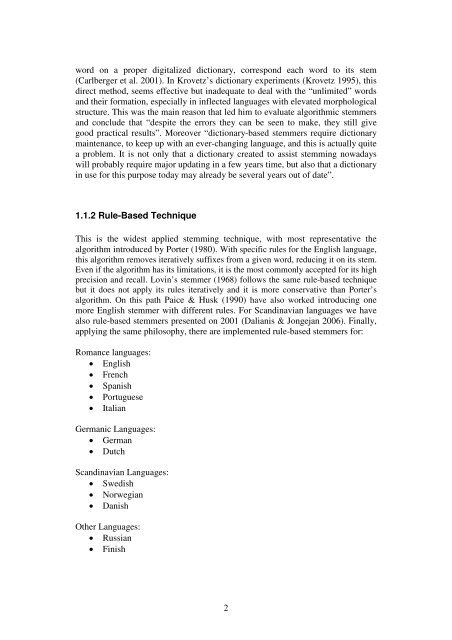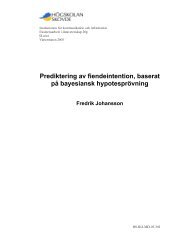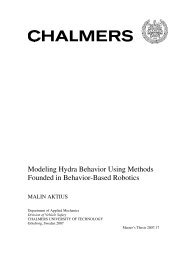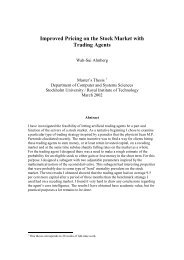Development of a Stemmer for the Greek Language - SAIS
Development of a Stemmer for the Greek Language - SAIS
Development of a Stemmer for the Greek Language - SAIS
Create successful ePaper yourself
Turn your PDF publications into a flip-book with our unique Google optimized e-Paper software.
word on a proper digitalized dictionary, correspond each word to its stem<br />
(Carlberger et al. 2001). In Krovetz’s dictionary experiments (Krovetz 1995), this<br />
direct method, seems effective but inadequate to deal with <strong>the</strong> “unlimited” words<br />
and <strong>the</strong>ir <strong>for</strong>mation, especially in inflected languages with elevated morphological<br />
structure. This was <strong>the</strong> main reason that led him to evaluate algorithmic stemmers<br />
and conclude that “despite <strong>the</strong> errors <strong>the</strong>y can be seen to make, <strong>the</strong>y still give<br />
good practical results”. Moreover “dictionary-based stemmers require dictionary<br />
maintenance, to keep up with an ever-changing language, and this is actually quite<br />
a problem. It is not only that a dictionary created to assist stemming nowadays<br />
will probably require major updating in a few years time, but also that a dictionary<br />
in use <strong>for</strong> this purpose today may already be several years out <strong>of</strong> date”.<br />
1.1.2 Rule-Based Technique<br />
This is <strong>the</strong> widest applied stemming technique, with most representative <strong>the</strong><br />
algorithm introduced by Porter (1980). With specific rules <strong>for</strong> <strong>the</strong> English language,<br />
this algorithm removes iteratively suffixes from a given word, reducing it on its stem.<br />
Even if <strong>the</strong> algorithm has its limitations, it is <strong>the</strong> most commonly accepted <strong>for</strong> its high<br />
precision and recall. Lovin’s stemmer (1968) follows <strong>the</strong> same rule-based technique<br />
but it does not apply its rules iteratively and it is more conservative than Porter’s<br />
algorithm. On this path Paice & Husk (1990) have also worked introducing one<br />
more English stemmer with different rules. For Scandinavian languages we have<br />
also rule-based stemmers presented on 2001 (Dalianis & Jongejan 2006). Finally,<br />
applying <strong>the</strong> same philosophy, <strong>the</strong>re are implemented rule-based stemmers <strong>for</strong>:<br />
Romance languages:<br />
• English<br />
• French<br />
• Spanish<br />
• Portuguese<br />
• Italian<br />
Germanic <strong>Language</strong>s:<br />
• German<br />
• Dutch<br />
Scandinavian <strong>Language</strong>s:<br />
• Swedish<br />
• Norwegian<br />
• Danish<br />
O<strong>the</strong>r <strong>Language</strong>s:<br />
• Russian<br />
• Finish<br />
2





